Readings Newsletter
Become a Readings Member to make your shopping experience even easier.
Sign in or sign up for free!
You’re not far away from qualifying for FREE standard shipping within Australia
You’ve qualified for FREE standard shipping within Australia
The cart is loading…






The first monographic publication in English on German Expressionist artist and architect Paul Goesch, whose extraordinary architectural fantasies were produced while he was institutionalized for schizophrenia
Artist and architect Paul Goesch (1885-1940) created one of the most inventive, peculiar, and poignant bodies of work to emerge from Weimar Germany. His vibrant drawings teem with invented ornament and resemble little else made then or since. Goesch, who exhibited widely in avant-garde circles, did so while institutionalized for schizophrenia-a condition for which he was ultimately murdered by the Nazi regime.
This monograph makes Goesch's extraordinary creations accessible to an English-speaking audience for the first time. It presents more than thirty examples of his drawings from the collection of the Canadian Centre for Architecture in Montreal, as well as work by his peers in the Expressionist "Glass Chain" group. Goesch's subject matter is mainly arches, passageways, and portals, which are taken here as a metaphor for the artist's anthroposophic beliefs and altered states and his liminal status as both an insider and outsider, whom critics have never been able to categorize clearly. The authors discuss Goesch's production and reception and posit his enduring art historical significance.
$9.00 standard shipping within Australia
FREE standard shipping within Australia for orders over $100.00
Express & International shipping calculated at checkout
The first monographic publication in English on German Expressionist artist and architect Paul Goesch, whose extraordinary architectural fantasies were produced while he was institutionalized for schizophrenia
Artist and architect Paul Goesch (1885-1940) created one of the most inventive, peculiar, and poignant bodies of work to emerge from Weimar Germany. His vibrant drawings teem with invented ornament and resemble little else made then or since. Goesch, who exhibited widely in avant-garde circles, did so while institutionalized for schizophrenia-a condition for which he was ultimately murdered by the Nazi regime.
This monograph makes Goesch's extraordinary creations accessible to an English-speaking audience for the first time. It presents more than thirty examples of his drawings from the collection of the Canadian Centre for Architecture in Montreal, as well as work by his peers in the Expressionist "Glass Chain" group. Goesch's subject matter is mainly arches, passageways, and portals, which are taken here as a metaphor for the artist's anthroposophic beliefs and altered states and his liminal status as both an insider and outsider, whom critics have never been able to categorize clearly. The authors discuss Goesch's production and reception and posit his enduring art historical significance.